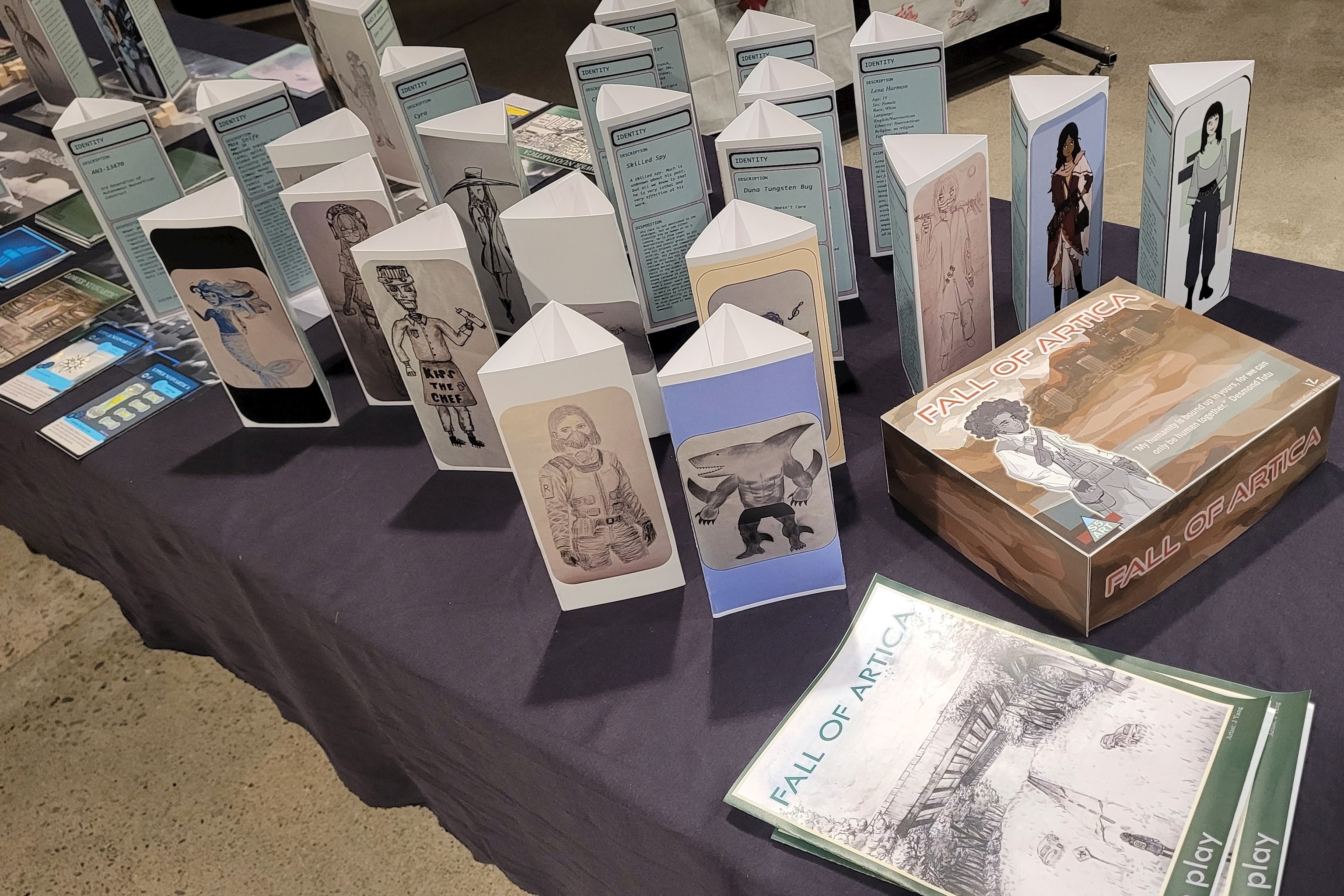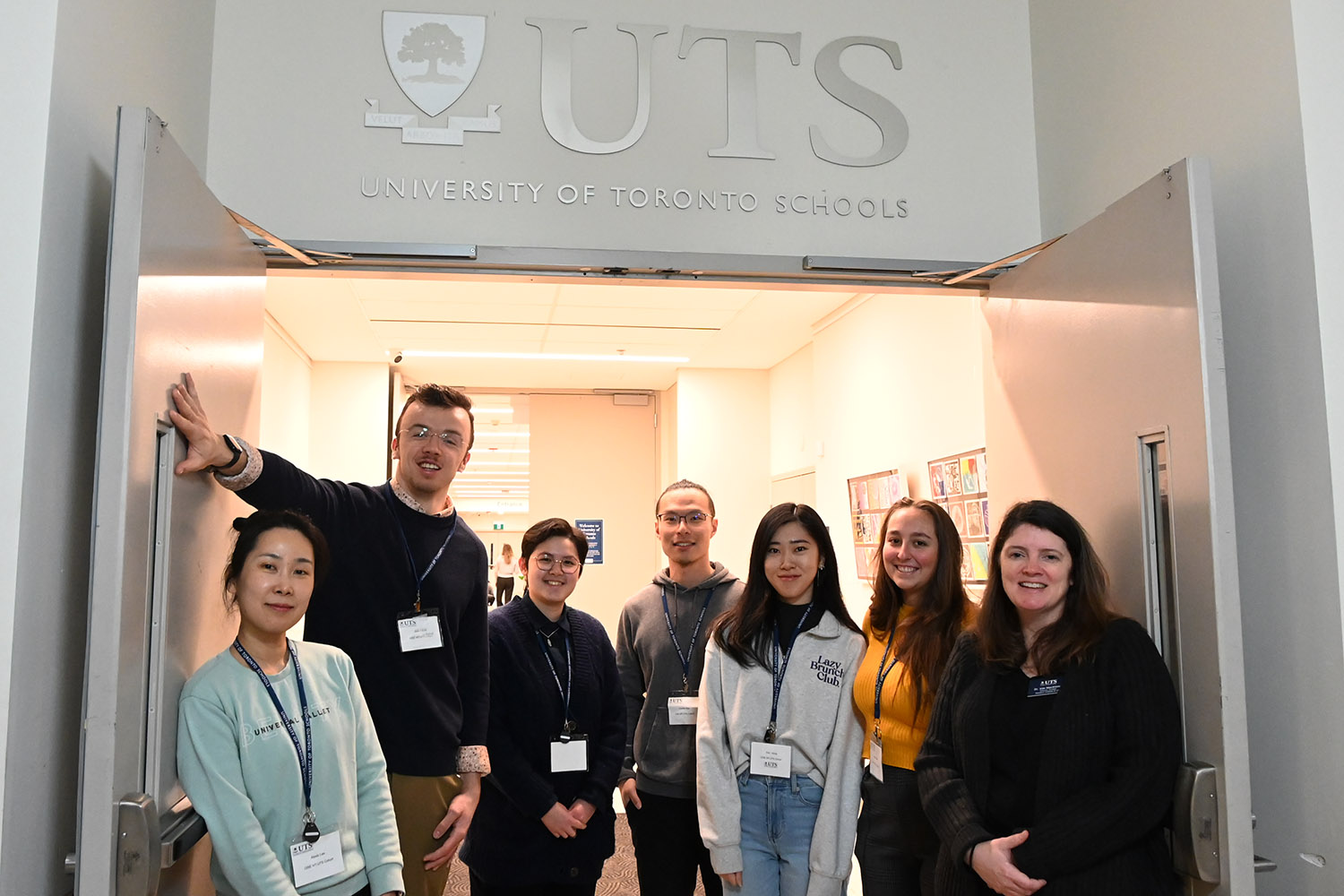371 Bloor Street West
Toronto, ON M5S 2R7 get directions
Toronto, ON M5S 2R7 get directions

OISE master of teaching candidates pictured with Dr. Kim MacKinnon (front centre left) and UTS Lang Innovation Lab staff, preparing to embark on an interactive activity in the Lab.
Over 110 years ago, UTS opened its doors as a lab school with a mission to provide a training ground for new teachers at the University of Toronto. Today, the tradition of UTS as a lab school continues with our decades-long partnership with the Ontario Institute for Studies in Education (OISE), providing school experience to master of teaching candidates, while forging vital connections between OISE researchers and the classroom to advance our collective knowledge about the practice of teaching and learning.
“The longevity of OISE’s partnership with UTS and the proximity of our institutions just five minutes away on Bloor Street creates a very close connection between OISE researchers and master of teaching candidates and UTS teachers and staff,” says Dr. Kim MacKinnon, who holds dual roles at both OISE and UTS. “With UTS moving in the direction of viewing research not as something external, but rather integrated into the daily life of the school it keeps the OISE graduate teacher education program feeling current beyond just theory, and provides a wonderful, rich experience for the candidates.”
Dr. MacKinnon serves as a bridge between the two institutions. While teaching as an assistant professor at OISE, she also oversees an annual cohort of about 30 OISE master of teaching candidates at UTS and holds the role of director of the Eureka! Research Institute at UTS, which is one of a small number of research institutes based on site at a school in Canada. Established with a transformational gift of $4.1 million from UTS alum Richard Ingram ’61 and Satoko Shibata, the Institute supports co-designed research that involves OISE and other U of T researchers, UTS teachers and staff, and sometimes even students. Research assistantships for the master of teaching candidates are funded through the Institute’s Co-design Innovation Fund.
The UTS cohort of OISE master of teaching candidates spends one day a week at the school under the leadership of Dr. Kim MacKinnon, observing teachers at UTS, and taking part in co-curriculars and workshops.
UTS classrooms have a history of serving as a lab school with OISE and the University of Toronto to develop and incorporate new teaching methods and strategies such as the teaching of the ‘new math’ in the 1960s, a U.S. strategy that signified a shift from memorization to students using their deductive powers to solve math problems, the creation of Ministry of Education guidelines for teaching gifted children, and more.
Over the years, many OISE and other U of T professors have worked in tandem with UTS, including OISE Professor Dr. Jim Slotta, who has fostered ongoing research relationships with UTS teachers for nearly 20 years, publishing more than 100 research papers in conjunction with his doctoral students from projects carried out at UTS, often with UTS teachers as co-authors. “I love the learning community and the idea that the classroom community would become a resource for itself,” says Professor Slotta, who is also the Professor and President’s Chair in Education and Knowledge Technologies at OISE. “The research co-design process allows OISE researchers to advance their ideas in close collaboration with UTS teachers by getting deeply involved in how the teachers think about their course and what they need for their curriculum. It’s a productive rehearsal of the research that improves the design of the research.”
A meeting of minds: OISE Professor Jim Slotta, doctoral student Kathy Zhou and UTS English Teacher Julie Stoyka collaborate on the next steps for the Fall of Artica, an interactive game being co-designed with Kathy, Julie, Visual Arts teacher Charlie Pullen and Julie and Charlie’s students.
In the early days of wikis circa 2006, Professor Slotta brought a wiki into a UTS physiology unit on human body systems, dividing students into groups for respiratory, circulatory and digestive systems. Collectively the class built knowledge about different diseases affecting these systems, flushing the wiki out with the symptoms of the disease, the impact in Canada and connections to other diseases. After just two class periods, with contributions from five classes, the wiki was complete with 23 diseases represented and more than 100 pages – all built by the students. Next, students created “disease cases” for their peers to solve, combining their team expertise on the body’s systems and growing their knowledge together. In 2012, Professor Slotta and OISE doctoral student Michelle Lui developed an ambitious project to transform an old storage room at UTS into a Sumatran rainforest, creating a fully immersive digital simulation using projectors. Dr. María Niño-Soto’s S5 (grade 11) Biology class used the room to explore topics of ecosystems and biodiversity, time-travelling as the room transformed through eight historical periods extending as far back as 200 million years ago. The historic rainforests came to life with input from the UTS students about the species of plants and animals to include. The project served as a means to study how students could interact in a collective immersive environment.
Through endeavours like these, Professor Slotta and his group have pioneered the learning model called Knowledge and Community Inquiry (KCI), in which students and teachers work collectively to advance their understanding of complex science topics, and apply this knowledge to inquiry projects. Now, his focus is shifting to add a deeper emphasis of meaning and purpose to learning. He and his group have launched a new initiative for all teachers (not just STEM) called the Critical Action Learning Exchange (CALE), that supports research and teaching in which students are empowered to go beyond theory to take action on pressing social and environmental problems.
“I want students to develop a confident understanding about why they’re in school,” says Professor Slotta. “Not just to get good grades or get into a good university – this is actually a destructive story that can lead to the wrong kind of learning, that is extrinsically motivated. CALE aims to empower teachers to make the curriculum personally relevant to students so they feel more positive about the future and believe that what they're learning is relevant and important.”

Over the last two school years, students in Charlie Pullen’s S5 (grade 11) Visual Arts classes designed assets for the Fall of Artica in partnership with OISE doctoral student Kathy Zhou and Professor Jim Slotta.
One CALE project underway at UTS is exploring how an interactive game can facilitate students’ critical thinking and collaboration skills. OISE doctoral student Kathy Zhou has been co-designing the project with UTS Visual Arts Teacher Charlie Pullen and English Teacher Julie Stoyka and their students, creating an alternate reality game called the Fall of Artica, in which a fictional dystopian world becomes the classroom, with students adopting roles and interacting with non-player characters in the form of AI chatbots to explore the dystopian themes as they intersect with classroom topics.
“Games are like interactive art,” says Pullen. “My Visual Arts students created characters for Artica, first coming up with character sketches and then developing them into character cards, and now we are working on other assets for the game, while Julie’s students are taking part in the creation of the game story with storytelling prompts. Our students have been playing games their entire lives, and now they're having the opportunity to get behind the scenes and learn how to build one.”
Technology came into play as Zhou and her team brought the characters to life using artificial intelligence, so students could converse with the characters they made using the OpenAI GPT3 large language. A paper on this aspect of the research by Zhou, with Pullen as one of the co-authors, won Best Technology Paper at the International Society of the Learning Sciences conference last year.
The Fall of Artica is still a work in progress as students and teachers help refine the game, but the interaction and collaboration on the challenges facing the dystopian world help students learn to solve problems similar to those faced in our world, which falls under CALE’s mandate.
This is one of several research projects underway at UTS. As a member of the UTS master of teaching cohort, Ian Hogeboom-Burr has served as a research assistant for Dr. MacKinnon and Dr. Cresencia Fong, the UTS head of innovation and research, since last year, working on their Collaborative Active Learning supported by Artificial Intelligence (CALAI) project, looking at technology that could leverage AI into the classroom.
The opportunity to be a research assistant is a unique aspect to an already-unique program – not many teacher education programs in Canada provide master-level programs that include professional teaching certifications, and the chance to take on assistantships that involve school-based practitioner research.
“At OISE, a lot of the research we talk about is very theoretical, so the opportunity to see the application to the classroom and be involved with focus groups with UTS students and teachers brings a practical element to the research that allows me to see where the research is going and how to make it useful,” says Hogeboom-Burr.

This year’s master in teaching research assistants funded through the Eureka! Research Institute at UTS are working on projects that range from therapy dogs to artificial intelligence to equity work and much more, pictured with Dr. Kim MacKinnon (right) and her Graduate Assistant Sonya Ho (third from left).
As part of the UTS cohort program, Hogeboom-Burr also completed a five-week practicum last school year at UTS alongside Physics Teacher Mary Hall, teaching S6 (grade 12) Physics. One lesson he created on two-dimensional momentum was based on NASA's DART mission, which aims to redirect asteroids away from earth through targeted collisions. The lesson was a success and other UTS science teachers heard about it and invited him for an encore with the AP Physics classes, which shows the learning flows both ways; not only do master of teaching candidates learn from UTS teachers, but UTS teachers benefit from the influx of new ideas from the candidates.
The learning also flows back to OISE. UTS teachers have a long history of also teaching part-time at OISE. Garth Chalmers, vice principal senior school; Dr. Kimberley Tavares, coordinating vice principal, anti-racism, equity, inclusion, access and program innovation; Mike Farley, geography teacher; and Sarah Shugarman, UTS music department co-ordinator, have taught there within the last year.
“OISE’s relationship with UTS is very much a two-way partnership,” says Anne Marie Chudleigh, associate director of the master of teaching program at OISE. “As institutions, we share the same deep commitment to many issues, including equity, social justice and breaking down systems and structures of oppression to remove barriers to access excellence in education. UTS is such a welcoming place for our master’s students to learn what it means to be an effective and successful teacher from some of the best in the field.”